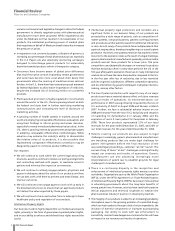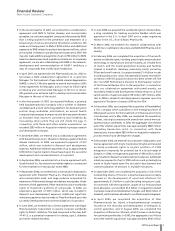Pfizer 2007 Annual Report Download - page 16
Download and view the complete annual report
Please find page 16 of the 2007 Pfizer annual report below. You can navigate through the pages in the report by either clicking on the pages listed below, or by using the keyword search tool below to find specific information within the annual report.
14 2007 Financial Report
Financial Review
Pfizer Inc and Subsidiary Companies
include discount rate; expected salary increases; certain employee-
related factors, such as turnover, retirement age and mortality (life
expectancy); expected return on assets; and healthcare cost trend
rates. Our assumptions reflect our historical experiences and our
best judgment regarding future expectations that have been
deemed reasonable by management. The judgments made in
determining the costs of our benefit plans can materially impact
our results of operations.
The following table shows the expected versus actual rate of
return on plan assets and the discount rate used to determine the
benefit obligations for the U.S. qualified pension plans:
2007 2006 2005
Expected annual rate of return 9.0% 9.0% 9.0%
Actual annual rate of return 7.9 15.2 10.1
Discount rate 6.5 5.9 5.8
Our assumption for the expected long-term rate of return-on-
assets in our U.S. pension plans, which impacts net periodic
benefit cost, was reduced from 9.0% for 2007 to 8.5% for 2008
to reflect that our strategic asset target allocation was modified
in late 2007 to reduce the volatility of our plan funded status and
the probability of future contribution requirements. Our target
allocations have been revised to increase the debt securities
allocation by 10% and to reduce the global equity securities
allocation by a corresponding amount. The assumption for the
expected return-on-assets for our U.S. and international plans
reflects our actual historical return experience and our long-term
assessment of forward-looking return expectations by asset
classes, which is used to develop a weighted-average expected
return based on the implementation of our targeted asset
allocation in our respective plans. The expected return for our U.S.
plans and the majority of our international plans is applied to the
fair market value of plan assets at each year end. For our
international plans that use a market-related value of plan assets
to calculate net periodic benefit cost, shifting to the fair market
value of plan assets would serve to decrease our 2008 international
pension plans’ pre-tax expense by approximately $27 million.
Holding all other assumptions constant, the effect of a 0.5
percentage-point decline in the return-on-assets assumption is an
increase in our 2008 U.S. qualified pension plan pre-tax expense
of approximately $38 million.
The discount rate used in calculating our U.S. pension benefit
obligations as of December 31, 2007, is 6.5%, which represents a
0.6 percentage-point increase from our December 31, 2006 rate
of 5.9%. The discount rate for our U.S. defined benefit and
postretirement plans is based on a yield curve constructed from
a portfolio of high quality corporate bonds rated AA or better for
which the timing and amount of cash flows approximate the
estimated payouts of the plans. For our international plans, the
discount rates are set by benchmarking against investment grade
corporate bonds rated AA or better. Holding all other assumptions
constant, the effect of a 0.6 percentage-point increase in the
discount rate assumption is a decrease in our 2008 U.S. qualified
pension plans’ pre-tax expense of approximately $77 million and
a decrease in the U.S. qualified pension plans’ projected benefit
obligations as of December 31, 2007, of approximately $696
million.
Analysis of the Consolidated Statement of
Income
YEAR ENDED DEC. 31, % CHANGE
__________________________________________ _________________
(MILLIONS OF DOLLARS) 2007 2006 2005 07/06 06/05
Revenues $48,418 $48,371 $47,405 —2
Cost of sales 11,239 7,640 7,232 47 6
% of revenues 23.2% 15.8% 15.3%
SI&A expenses 15,626 15,589 15,313 —2
% of revenues 32.3% 32.2% 32.3%
R&D expenses 8,089 7,599 7,256 65
% of revenues 16.7% 15.7% 15.3%
Amortization of
intangible assets 3,128 3,261 3,399 (4) (4)
% of revenues 6.5% 6.7% 7.2%
Acquisition-related
IPR&D charges 283 835 1,652 (66) (49)
% of revenues 0.6% 1.7% 3.5%
Restructuring charges
and acquisition-
related costs 2,534 1,323 1,356 92 (2)
% of revenues 5.2% 2.7% 2.9%
Other (income)/
deductions—net (1,759) (904) 397 95 *
Income from
continuing
operations(a) 9,278 13,028 10,800 (29) 21
% of revenues 19.2% 26.9% 22.8%
Provision for taxes
on income 1,023 1,992 3,178 (49) (37)
Effective tax rate 11.0% 15.3% 29.4%
Minority interest 42 12 12 235 4
Discontinued
operations—net
of tax (69) 8,313 498 *M+
Cumulative effect of
a change in
accounting
principles—net
of tax —— (23) **
Net income $ 8,144 $19,337 $ 8,085 (58) 139
% of revenues 16.8% 40.0% 17.1%
(a) Represents income from continuing operations before provision
for taxes on income, minority interests, discontinued operations
and cumulative effect of a change in accounting principles.
* Calculation not meaningful.
M+ Change greater than 1,000%.
Percentages in this table and throughout the Financial Review may
reflect rounding adjustments.
Revenues
Total revenues were $48.4 billion in 2007, flat compared to 2006,
primarily due to:
•an aggregate increase in revenues from Pharmaceutical
products launched in the U.S. since 2005 of $2.0 billion and from
many in-line products in 2007;
•the weakening of the U.S. dollar relative to many foreign
currencies, especially the euro, U.K. pound and Canadian dollar,
which increased revenues by $1.5 billion, or 3.0%, in 2007; and
•increased revenues in our Animal Health segment and other
businesses of $706 million in 2007,
























